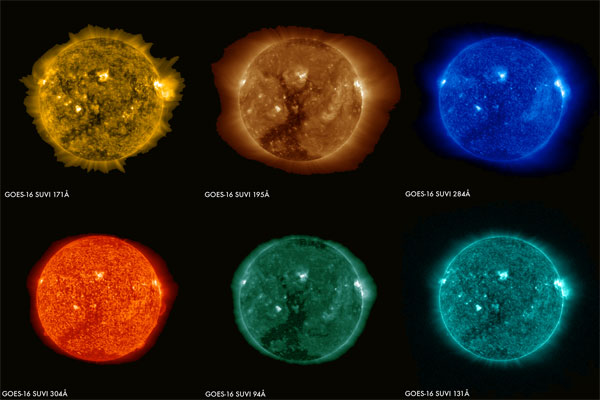
First Solar Images from GOES-16
February 27, 2017
This animation from January 29, 2017, shows a large coronal hole in the sun’s southern hemisphere from the Solar Ultraviolet Imager (SUVI) on board NOAA's new GOES-16 satellite. The animation captures the sun in the 304 Å wavelength, which observes plasma in the sun's atmosphere up to a temperature of about 50,000 degrees. When combined with the five other wavelengths from SUVI, observations such as these give solar physicists and space weather forecasters a complete picture of the conditions on the sun that drive space weather.
The first images from the Solar Ultraviolet Imager (SUVI) instrument aboard NOAA’s GOES-16 satellite captured a large coronal hole on the sun on January 29, 2017. The sun’s 11-year activity cycle is currently approaching solar minimum and during this time powerful solar flares become scarce and coronal holes become the primary space weather threat. Once operational, SUVI will capture full-disk solar images around-the-clock and will be able to see more of the environment around the sun than earlier NOAA geostationary satellites.
The sun’s upper atmosphere, or solar corona, consists of extremely hot plasma, an ionized gas. This plasma interacts with the sun’s powerful magnetic field, generating bright loops of material that can be heated to millions of degrees. Outside hot coronal loops, there are cool, dark regions called filaments which can erupt and become a key source of space weather when the sun is active. Other dark regions are called coronal holes, which occur where the sun’s magnetic field allows plasma to stream away from the sun at high speed, resulting in cooler areas. The effects linked to coronal holes are generally milder than those of coronal mass ejections, but still pose risks to Earth.

GOES-16 Data and Imagery Gallery These images of the sun were captured at the same time on January 29, 2017 by the six channels on the SUVI instrument on board GOES-16 and show a large coronal hole in the sun’s southern hemisphere. Each channel observes the sun at a different wavelength, allowing scientists to detect a wide range of solar phenomena important for space weather forecasting.
The solar corona is so hot that it is best observed with X-ray and extreme-ultraviolet (EUV) cameras. Various elements emit light at specific EUV and X-ray wavelengths depending on their temperature, so by observing in several different wavelengths, a picture of the complete temperature structure of the corona can be made. The GOES-16 SUVI observes the sun in six EUV channels.
SUVI will allow the NOAA Space Weather Prediction Center to provide early space weather warnings to electric power companies, telecommunication providers and satellite operators. Depending on the size and the trajectory of solar eruptions, impacts to Earth can result in geomagnetic storms which disrupt power utilities, communication and navigation systems, and may cause radiation damage to orbiting satellites and the International Space Station.